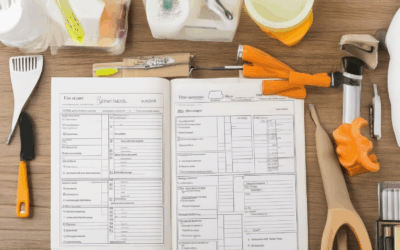Are you looking to improve your home but feel overwhelmed by the endless possibilities and unclear where to begin? Whether you’re a seasoned pro or just starting out, basic home improvement can transform your living space into something truly special. This guide dives into the essential aspects of home renovation, offering insights, tips, and solutions to address your most pressing questions. From planning your project to understanding the renovation process, we’ll cover everything you need to know to execute a successful home improvement venture. Discover cost-saving strategies, explore DIY home projects that make a big impact, and learn how to stay within your budget while maximizing the value of your home. With this comprehensive guide, you’ll be equipped with the knowledge to tackle even the most daunting tasks with confidence. Let’s get started and unlock the potential of your home!

What Home Improvement Should I Do First?
To determine the best home improvement projects to tackle first, consider the impact, functionality, and urgency of each project. Here’s a structured approach:
- Kitchen Renovation – Start with the kitchen as it is often the highest priority due to its daily use and visibility. Update appliances, replace countertops, and refresh cabinetry.
- Bathroom Renovation – Next, focus on the bathroom to enhance hygiene and comfort. Repair or replace tiles, update fixtures, and improve grout.
- Flooring – Address uneven floors or damaged hardwood to ensure stability and aesthetics. Consider refinishing or replacing carpets.
- Master Bedroom Refresh – Create a more inviting space with fresh paint, updated bedding, and modern decor. Improve lighting for better ambiance.
- Deck Repair – Fix structural issues and restore the deck to extend outdoor living space and enjoyment.
Plan the sequence considering difficulty, budget, and personal capabilities to avoid overwhelm. Prioritize high-impact areas first for maximum benefit and comfort.
Is 20,000 Enough to Remodel a House?
A $20,000 budget can certainly be sufficient for a well-planned home remodel, particularly if you focus on targeted areas that offer the most impact for the lowest cost. Here’s how you can achieve a successful remodel within this budget:
- Kitchen Upgrade: Replace outdated countertops with mid-range materials, which typically cost between $3,000 and $6,000. Add new appliances, ranging from $2,000 to $5,000, to modernize your space.
- Bathroom Refresh: Opt for a small-scale bathroom remodel, such as updating the shower, installing new tile, or repainting walls. This can cost between $3,000 and $7,000, depending on the scope.
- Flooring Installation: Install new flooring throughout your home using affordable materials like laminate or vinyl. Costs typically range from $3 to $8 per square foot, making it a budget-friendly option.
- Exterior Enhancements: Boost curb appeal with a fresh coat of paint, updated window treatments, or a small porch addition. These projects can significantly improve your home’s appearance without breaking the bank.
- Labor Costs: Factor in labor expenses, which generally add 15% to 30% to material costs. To save money, consider handling some tasks yourself, such as painting or demolition work.
By focusing on these key areas and prioritizing cost-effectiveness, you can achieve a remodel that enhances both functionality and aesthetics within your $20,000 budget. Remember to plan carefully, shop for deals, and consider DIY options to maximize your investment.

What Are the 5 Stages of Home Renovation?
Renovating your home can be an exciting process, but it’s important to approach it systematically. Below, we outline the five key stages of a successful home renovation project:
- Planning and Design Phase
- Preparation Phase
- Execution Phase
- Finishing Touches Phase
- Punch List and Final Review
1. Planning and Design Phase
This is the foundation of any successful renovation. Start by assessing your space, determining your goals, and gathering inspiration. Consider your budget, timeline, and the functionality you want to achieve. Sketch out your ideas or use design software to plan layouts. This phase is crucial for ensuring your renovation stays on track.
2. Preparation Phase
Before any physical work begins, prepare thoroughly. This includes obtaining permits, hiring reliable contractors, and setting a detailed schedule. Protect your belongings by moving furniture and securing fragile items. Establish a waste management plan and decide on temporary storage solutions for materials and tools.
3. Execution Phase
This is where the actual work happens. Begin with demolition, carefully removing old fixtures, walls, and flooring. Install new structural components like drywall, insulation, and electrical systems. Stay involved to ensure everything aligns with your vision, and communicate regularly with your team to address any issues promptly.
4. Finishing Touches Phase
Once the major structural work is complete, focus on the finishing details. Paint walls, install flooring, and choose lighting fixtures. Add decorative elements like artwork, curtains, and rugs to personalize your space. Ensure all plumbing and electrical systems are functional and safe.
5. Punch List and Final Review
Before declaring the renovation complete, conduct a final walkthrough to identify any missed details. Address remaining tasks like landscaping, fencing, or deck installation. Schedule a professional inspection to ensure everything meets local codes and safety standards. Once everything is in order, you can enjoy your newly renovated home.
By following these stages, you’ll navigate your home renovation project with confidence, ensuring a successful outcome that enhances both your living space and property value.

Basic Home Remodeling: A Step-by-Step Guide
A basic home remodeling project can transform your living space into something fresh and modern. Whether you’re aiming for a full overhaul or just a few updates, planning carefully is essential. Here’s a breakdown of the key steps and considerations:
1. Planning and Preparation
- Budgeting:** Determine your budget early on. Consider factors like labor costs, materials, and unexpected expenses.
- Design Ideas:** Sketch out your vision or browse inspiration online. Consider functionality and how each change will impact daily life.
- Permits:** Check local regulations to ensure your project complies with building codes. Some remodels may require permits.
- Tools Needed:** Gather essential tools like measuring tape, screwdrivers, and paintbrushes. For larger projects, consider renting equipment.
2. Selecting Materials
- Flooring:** Choose from options like hardwood, tile, or carpet based on your lifestyle and home decor style.
- Countertops:** Decide between granite, quartz, or laminate countertops depending on durability and aesthetic preferences.
- Paint Colors:** Select paint colors that complement your existing furniture and flooring. Light colors can make spaces feel larger.
- Lighting:** Update outdated light fixtures with modern options like LED lighting for energy efficiency and ambiance.
3. Demolition and Prep Work
- Remove Old Features:** Take down old cabinets, countertops, or wall coverings. Properly dispose of waste materials.
- Clean Up:** Dust and debris can affect the progress, so keep areas tidy to maintain workflow.
- Plumbing and Electrical:** If you’re repositioning fixtures, plan ahead to avoid costly mistakes. Consider hiring a professional for complex tasks.
4. Installation and Assembly
- New Cabinets:** Install custom or prefabricated cabinetry. Ensure measurements are accurate to avoid gaps.
- Countertops:** Secure new countertops using adhesives or clamps. Allow for proper drying time post-installation.
- Painting:** Apply primer and paint walls, ceilings, and trim evenly. Consider using a roller for large areas and brushes for details.
- Final Touches:** Add decorative elements like mirrors, artwork, or plants to complete the look.
5. Finalizing the Space
- Testing:** Run water and appliances to ensure everything functions properly. Inspect for leaks and damage.
- Clean-Up:** Wipe down surfaces and sweep floors to leave the space in its best condition.
- Inspection:** Have your work inspected by a professional if required, to ensure compliance with local codes.
Additional Tips for Success
- Stay Organized:** Keep tools and materials organized to save time and reduce stress.
- Work Safely:** Use ladders safely and wear protective gear when handling heavy objects.
- Hire Professionals:** For complex tasks like electrical work or plumbing, consider hiring licensed contractors.
- Enjoy the Result:** Take a step back and enjoy the transformed space that reflects your personal style!
Remember, basic home remodeling is about making thoughtful decisions and staying focused on your goals. With proper planning and execution, you can achieve a stunning transformation that enhances both functionality and aesthetics.
Correct Order to Renovate a House
Here’s a step-by-step guide to help you plan and execute a successful home renovation:1. **Assess Structural Integrity** Begin by inspecting the foundation, walls, and roof for any signs of damage or wear. Address issues like termite infestations or water damage early to prevent further complications.2. **Plan Interior Layout** Before making any changes, sketch out your desired layout. Consider room configurations, new additions, and how spaces will function after renovation.3. **Update Electrical System** Modernize or repair the electrical system to ensure safety and compliance with current building codes. Install new outlets and circuits as needed.4. **Upgrade Plumbing Systems** Replace outdated pipes and fixtures. Plan for new installations such as smart sinks or water-saving fixtures to enhance functionality.5. **Replace HVAC Systems** Update or replace aging heating, ventilation, and cooling systems to improve energy efficiency and indoor air quality.6. **Choose Finishes and Materials** Select paint colors, flooring options, countertops, and cabinetry. These decisions will significantly impact the home’s aesthetic and functionality.7. **Start Demolition and Installation** – **Kitchen and Bathrooms**: Begin with high-traffic areas. Remove outdated cabinets, install new fixtures, and update plumbing. – **Other Areas**: Progress to bedrooms, living spaces, and outdoor areas like decks or patios.8. **Landscape the Property** Enhance your home’s curb appeal by planting new gardens, installing a patio, or upgrading the lawn.9. **Apply Final Touches** Finish with tasks like painting walls, hanging wallpaper, and installing window treatments to complete the transformation.By following this sequence, you’ll ensure your renovation is well-organized and executed efficiently.
What is the cheapest renovation ideas?
Renovating your home doesn’t have to break the bank. Here are some cost-effective ideas to refresh your space:
- Paint Your Walls – A fresh coat of paint can transform a room and is one of the most affordable upgrades.
- Add Shelving – Install open shelves in kitchens, bathrooms, or living areas to store items neatly and save space.
- Use Plywood for Accents – Transform furniture or surfaces with plywood for a unique, budget-friendly look.
- Update Lighting – Replace outdated light fixtures with modern ones or add LED strips for a quick upgrade.
- Refinish Cabinets – A good scrub and fresh coat of paint can breathe new life into your kitchen or bathroom cabinets.
- Install New Door Handles – A simple hardware upgrade can elevate the look of your doors without much effort.
- Plant More Plants – Add greenery to your home to improve air quality and aesthetics, while saving money on expensive decor.
Quick Fixes vs. Long-Term Projects
For those looking to spend minimal money, focus on quick fixes that deliver maximum impact:
- Quick Fixes
- Repainting walls
- Updating door handles
- Adding basic shelving
- Switching out light fixtures
- Long-Term Projects
- Refinishing cabinetry
- Installing new flooring (e.g., vinyl or linoleum)
- Building simple furniture pieces
- Upgrading window treatments
Remember, sometimes the cheapest renovations are the ones that require the most creativity and repurposing of materials you already have. With a little effort, you can transform your space into something stunning without spending a fortune.
Looking for more inspiration? Check out our DIY Projects guide or explore our Home Improvement Tips for more budget-friendly ideas.




0 Comments